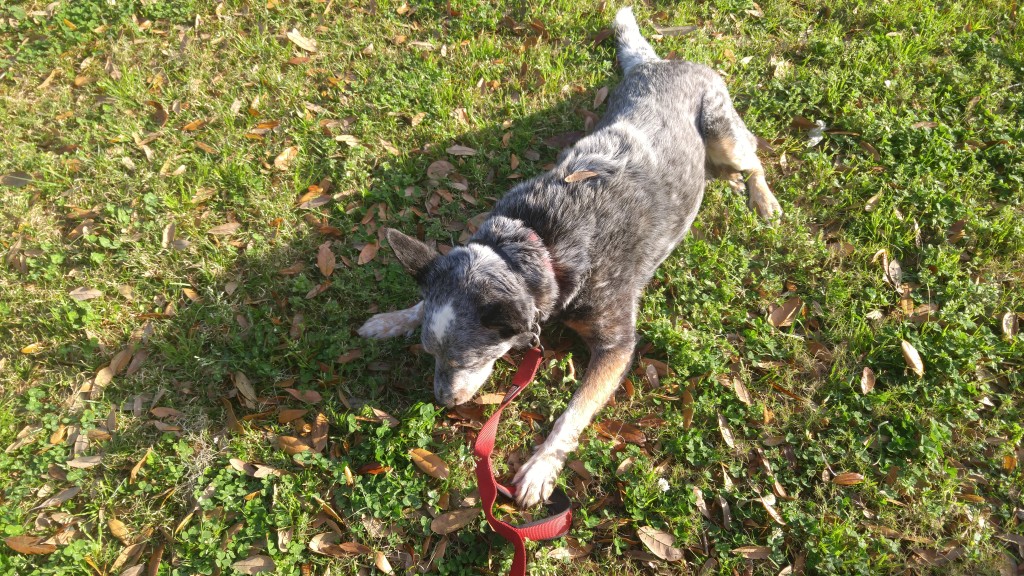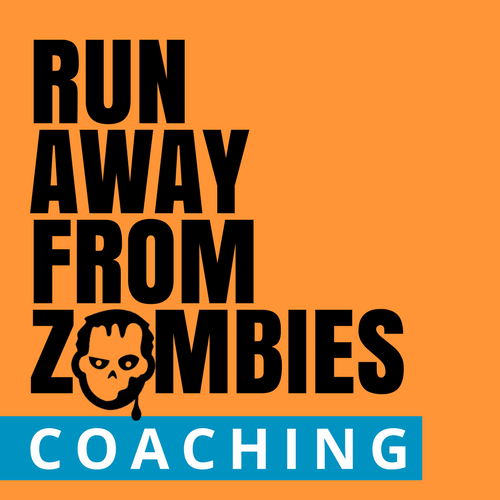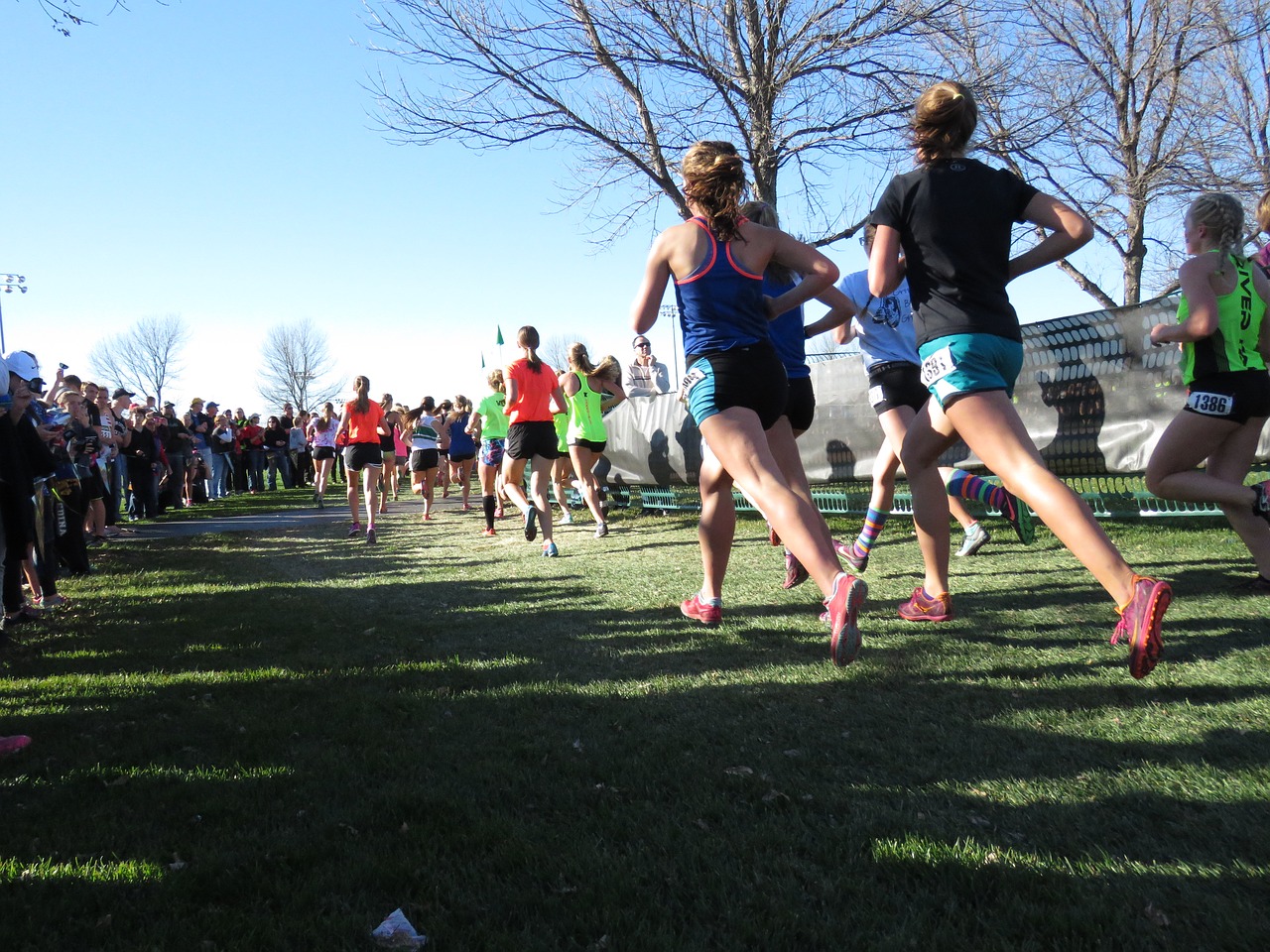The first time you try anything, offer yourself grace.
Grace started when I got home on Speedwork Wednesday and the sun was already setting. I hadn’t gotten a chance to eat much. Work left me exhausted. It was not the time to push my body into something new.
So, grace.
On Speedwork Wednesday Thursday, I put on my stopwatch and tried something new. Running Buddy M (RBM) asked to come. Sure. The park was full of people enjoying the weather. Sure. Oakley, the dog, wanted to go on the warm-up run. Sure.

Hey look Ma, I found a leaf.
Grace, remember?
What is interval speedwork?
Interval speedwork alternates between periods of hard running at a specific pace and rest through walking or jogging. You can measure by time or by distance. Common distances are 200, 400, 800m, and 1 mile.
The Hal Higdon Intermediate 5K program I’m doing prescribes interval speed training every other week. After a warm up, you run 400 meters at your 1 mile pace. Then you recover by jogging or walking another 400 meters. The first week you do this for 5 repetitions. The plan builds to 8 repetitions.
Why interval speedwork?
According to Active.com interval speedwork helps you in 3 ways:
- Your body becomes more efficient at removing the lactic acid that builds up in your muscles (which signals fatigue to your brain).
- Your endurance increases for faster paces. You will be able to run faster for longer.
- Strength and flexibility are gained in different muscles than in moderate speed running. It will increase overall muscle performance during races.
All of those benefits sound great for 5K training. While breathing was the limiting factor in my baseline 5K, I think my body was working ineffectively in general. And even though I’m only a week into my training, I am gaining an appreciation for the core and leg strength required for short distance running.
Further reading for interval speedwork:
- Competitor.com’s Running 101: Basic speed workouts for runners
- Active.com’s Use interval training to hit your 5K and 10K potential (source of benefits list above)
- Breaking Muscle’s Performing interval run workouts: a step by step guide

So ready.
My first distance interval speedwork
I came into speedwork a little nervous, but with more wisdom. Over the past couple of years, I’ve tried new things in running and I’ve learned that just like your first runs EVER — things aren’t pretty.
I’ve also learned that things get better if you put time into it. The first time I tried to run 9 miles, I was so hard on myself that I quit running for months. But, if you give yourself a little grace and a little more opportunity, you can overcome the learning curve and succeed.
This week I approached interval training with humor. I was OK with not knowing anything.
The first thing I didn’t know was my “1 mile pace”.
I’ve never timed myself for a 1 mile distance. Is that weird? Maybe not for a long distance runner.
I plugged my baseline 5K time into a race time predictor, which reported a 7:32 for a 1 mile race. I divided it by 4 to get to get 1 min, 52 sec (1:52) to cover the ~400 meters. I also knew an 8 minute mile would be 2:00 per 400 meters. I decided to try those numbers out and see how they felt.
I used the 1/4 mile markers in the park. 0.25 miles is actually 402.3 meters, but we won’t split hairs meters.
RBM and I warmed up with 2 miles and some sprints thrown in at the end. RBM decided to match my pace since his running has been sporadic.
For basically the entire workout, we discussed our pace. Were we going too fast? Too slow? Was this the correct pace to pick? We walked at the beginning of the recovery period and jogged the rest. I felt like I was holding myself back, but also knew that there were more repeats to go AND that you aren’t supposed to feel dead after speedwork.
“How many have we done?” I asked. I had stopped midway during one of our repeats when I saw good friend, so I was a little lost.
“Four.” RBM said so quickly and confidently that I didn’t double-check. So we ran one more.
We ran 1:42, 1:36 (the marker was missing, so we started late), 1:50, 1:55, 1:57, 1:57.
Note that’s 6 repeats, rather than the prescribed 5. Next time, I’m counting.
After distance interval speedwork
When I got home I felt invigorated, not completely depleted. Although I barely remember inhaling a leftover burger in the fridge.
Later that night I used the massage roller on my legs and iced my knees, since I wasn’t sure how my body was going to react. The next morning I was sore in atypical leg muscles, which matches up with that 3rd benefit on the list above.
I didn’t focus on my form or stride length during the intervals. It is a great opportunity to do so, but the thought floated away when I hit start on the stopwatch.
I’m revisiting my “1 mile pace” because I was able to converse with RBM during the hard intervals, and we did 6 without much trouble.
But if my new mile pace doesn’t work out, I’ll apply a little grace, and try again.






Spot on with this write-up, I honestly believe that this amazing site needs much more attention. I’ll probably be back again to read more, thanks for the information!